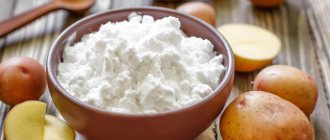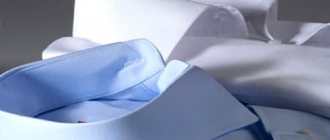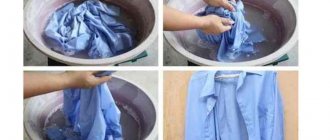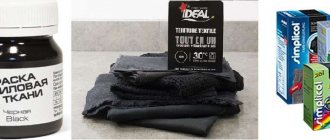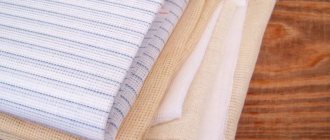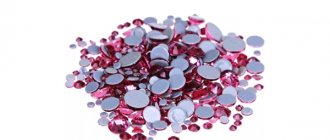Napkins always play a big role in table setting; they also look beautiful without a festive table; with them, the house looks cozier and warmer, especially when the napkin is knitted by the hands of the homemaker.
A starched napkin will look much more beautiful and elegant; it can be shaped, it will have a finished, impeccable look. Those who think that starching various things in our time is irrelevant and old-fashioned are mistaken.
This method is still a necessity now; starched things look much more beautiful and elegant. This is not difficult to do, the process is not labor-intensive and takes a little time, the main thing is to know how to starch correctly . There are several ways to make any napkin look perfect and elegant.
Cooking features
The required consistency for jelly is given by the starch added to their recipe or a substance that can perform its function - corn starch or cereal flour (oats, rice, flax).
But in order to get the desired density of the drink, you need to follow the prescription dosages - how much thickener to add. The method of cooking jelly from starch so that it turns out liquid differs only in its proportion. Even inexperienced housewives can cope with this task. Knowing how to properly cook jelly from starch, you can adjust its consistency yourself. According to standard standards - for 1 liter of jelly, how much starch needs to be diluted are the following indicators:
- Liquid jelly is prepared from 1 tbsp. l. starch.
- The amount of starch for medium-thick jelly is 2 tbsp. l.
- For thick jelly, add 4 tbsp. l. starch.
There are many ways to prepare jelly from starch and berries. But the best is still considered to be ready-made juice, on the basis of which the drink is brewed. It's fast, tasty and natural.
One of the most common recipes among housewives is how to cook thick jelly from starch and juice:
Take 1 liter of juice. Add 2-3 tbsp to 750 ml of juice. l. Sahara. The amount may vary depending on the sweetness of the berry. Boil the juice. While the berry syrup is boiling, dilute 2 tbsp in 1 glass of cold juice. l
potato starch. Carefully pour the starch mixture into the boiling syrup and bring to a boil, turn off. Leave until cool.
The method for diluting starch for jelly can be different: it can be diluted in the base of the drink - juice or compote, milk, or in cold water. Some housewives use a less troublesome method - how to dilute starch for jelly. They simply add it to the liquid composition immediately, but increase the cooking time by 1-2 minutes.
It is very important how much starch is needed for jelly prepared for small children. According to the technological map compiled for preschool institutions, no more than 1.5 g of starch should be added per 100 g of finished product.
The recipe for jelly with starch and juice allows you to prepare a very aromatic, tasty and equally healthy dessert.
What can you make paste from?
Flaws:
- Making the mixture yourself is a little more difficult and will require more of your time than if you buy ready-made glue in the store;
- The finished mixture cannot be stored for more than a day; if you put the remaining mixture in the refrigerator, its shelf life will extend by two days.
The most popular ingredient is second and third grade flour; it can be wheat, corn or rye. Starch is less in demand.
To properly prepare a starch paste, you must strictly observe all proportions, since the mixture should be not too liquid and not too thick. We offer you several universal recipes.
Recipe No. 1. Paste based on starch flour
Important: the finished mixture should be similar in consistency to liquid sour cream.
Recipe No. 2
Cooking method:
- - mix starch and flour in equal proportions, add water;
- - stir and put on fire, bring to a boil;
- - Boil for several minutes, while constantly stirring the mixture.
- - after the mixture has cooled, you can add PVA glue.
Recipe No. 3
We recommend using potato starch to prepare the paste, as it has the highest adhesive ability.
- - Pour 3 teaspoons into a glass of boiling water, we recommend pouring in a thin stream, this will avoid the formation of lumps;
- - beat the mixture with a whisk;
- — let the mixture cool slightly, then strain through cheesecloth;
- - put the mixture in a water bath;
- — the paste needs to be stirred constantly;
- — If you plan to use a ready-made solution for wallpapering, we recommend adding PVA glue.
Kissels are prepared from almost all fresh berries and fruits - cranberries, currants (red and black), raspberries, strawberries, blueberries, cherries, apples, plums, dogwoods, apricots. Perhaps the only thing I haven’t seen is pear and peach jelly.
Jelly is made from dried fruits, fruit juices and red wine. Milk jelly - made from cow's and almond milk. Kissel can even be made from kvass and honey. And finally, a dish for those who prefer chocolate to all other joys of life - chocolate jelly, which in overseas countries is sometimes called pudding.
Such different jelly: from berries and fruits, based on milk and even chocolate
Blouses and shirts turn to stone: how to starch fabric with a solution, PVA glue and gelatin
Alina Borisova Author of the site Moy-clean.ru
Starching fabric is not as popular today as it used to be. When our grandmothers were young, every self-respecting housewife considered it important to starch certain types of clothing (blouses, shirts), and the need for this procedure for bed linen and tablecloths was not discussed at all.
Starched items retain their presentable appearance and freshness longer due to the elasticity acquired during the processing process. Unfortunately, due to the completely different style and rhythm of modern life, today not every housewife knows how to starch fabric.
Three ways
At home, fabric can be starched in three ways. The choice of the optimal one depends on the type of fabric and the purpose of the product:
The soft way. Used for dresses, blouses and bed linen made of thin, delicate fabrics: muslin, cambric and the like.
Semi-hard way. It is used for starching men's shirts, as well as napkins and tablecloths. In this case, a solution of a higher concentration is required: at the rate of a full tablespoon of starch per liter of water.
The cuffs and collars of shirts are starched using a harsh method. To do this, the concentration of the solution must be even higher - you will need at least two tablespoons of starch per liter of water.
Starch solution
For the first two methods, the recipe for preparing the starch mixture is the same, the only difference is in the amount of starch brewed.
We start by diluting the starch in cool water. Then the resulting mixture is poured into boiling water in a thin stream, while stirring it. You should try to stir continuously to avoid the formation of lumps. The finished solution should be transparent. If it is a little cloudy, you should boil it a little more and add water.
Stir and allow to cool to a moderately warm state, then immerse the product in the solution.
If the fabric is to be starched in a harsh way, borax, that is, sodium boric salt, is added to the solution. A teaspoon of borax is diluted separately in a small amount of hot water and added to the completely prepared solution, stirring thoroughly and letting it brew for at least two hours.
Alternative option
Sugar. Syrup is boiled from it, which serves as a solution that gives the product rigidity and the desired shape.
When the syrup boils, add starch previously diluted in cold water. The mixture must be stirred constantly to prevent the formation of lumps. The product is dipped into the resulting mass, left for a while, then removed, squeezed out and given the desired shape. The disadvantage of this method is that the product cannot be wetted, so after washing the procedure will have to be repeated.
PVA glue can be used to starch both knitted items and fabric for various types of needlework.
To do this, prepare a water-adhesive solution in the proportion: one part of glue to one or two parts of water, depending on the thickness of the PVA. The product is dipped into the solution or coated with it, given its final shape and allowed to dry completely.
The gelatin method is also “disposable”. To use it, you should soak one spoon of gelatin in cold water. After swelling, you need to bring the volume of water to 200-250 grams and heat it. When the gelatin has completely dissolved, the solution is ready to form the product.
For some types of needlework, starching fabric is an integral part of the process of creating a product. For example, for making flowers, the methods described above are the most acceptable and convenient.
It is only necessary to vary the saturation of the solution depending on the type of fabric.
The principle usually works: the thinner the fabric, the stronger the starch solution should be.
Do not forget that all fabrics and products are subject to starch, with the exception of:
- underwear, since starching makes things airtight, which is unhygienic;
- dark and black things: starch leaves whitish marks on them;
- products whose fabric contains synthetic fiber.
Why starch textiles, and when should you not do it?
[turbobutton]
During the process of starching the fabric, its fibers are impregnated with polysaccharides. A thin film is formed on the surface of the threads, which increases their density and elasticity. As a result of starching, textiles hold their given shape well, bleach, crumple less and “creak” when touched. In addition, products stay clean longer and are easier to wash, since the starch film repels dirt and does not allow it to penetrate deeply into the fibers.
The disadvantage of starching is the fact that it reduces the breathability of the fabric. It is not recommended to process:
- summer clothes (it is advisable to starch only individual parts);
- underwear (they may become stiff and cause discomfort);
- dark products (starch can change their shade);
- synthetic fabrics (the solution is not fixed to their fibers);
- things embroidered with floss threads (they can stick together and lose their shine).
Important: Only clean things are starched. If there are stains on the product, they must first be removed.
How to make potato starch
If you want to make starchy powder with your own hands, it is important to choose the appropriate fruits, follow the recipe and carry out all the actions that are usually performed in production
How to choose potatoes
At home, potato starch is made from fruits that contain a large amount of this substance - from 20-25% and above. This indicator is influenced by the variety of root crop. The most starchy varieties are Lorch, Woltman, etc. A large amount of the final product is obtained from them.
Advertisements
Innovative shovel "Harvest"
To correctly select potatoes with a high starch content, cut the root crop in half and carry out simple experiments:
- Rub the cut of the tuber onto the palm of your hand. If there is a lot of starch, a powdering effect is felt on the skin;
- The cut potatoes are left in the air for 20-30 minutes. When moisture evaporates, a starchy film forms on the cut surface. The faster it appears, the more useful substance in the tuber.
Potato connoisseurs note: brown-skinned potato tubers have a high starch content. This root vegetable quickly crumbles when cooked. It makes an excellent puree.
You cannot get starch from spoiled, frozen potatoes. The beneficial substances in it turn into sugars, which dissolve in water. Small root vegetables are not suitable for this. These potatoes have a lot of fiber and a starch content of 8-10%.
Potato starch contains several components important for digestion. Among them are carbohydrates, proteins, saccharides, etc. The loose white, tasteless powder contains useful minerals: calcium, potassium, phosphorus.
The laws of jelly!
- Starch does not dissolve in liquid. If you dilute it in water (milk) in advance, it will settle to the bottom, so before brewing the jelly, the starch must be mixed again.
- The starch should be poured in while continuously stirring the jelly.
- Under no circumstances should jelly be boiled for a long time. When boiled, starch turns into glucose - this is pure chemistry. It may seem to you that the jelly is not thick enough, and you will want to cook longer, but with every minute it will become thinner and thinner. Therefore, remember: half a minute after boiling is enough for the jelly to be ready. And immediately remove from the heat - the jelly is ready!
- Some jelly, for example, cranberry, are not recommended to be cooked in an aluminum container - it will take on an unappetizing color.
Recipe for delicious jelly based on jelly made from starch and berries
By playing with the amount of starch used, you can prepare not only a drink - jelly, but also jelly-jelly or delicious jelly jelly, mousse. For example, on a curd and sour cream base you can make jelly-jelly.
To prepare it, just take 200 ml. sour cream and 400 gr. Cottage cheese. Mix sour cream with cottage cheese and set aside in a container. In the meantime, take gelatin, 20 g is enough. And dilute it in a small amount of warm water.
We start cooking the jelly in the same way as in the first recipe. When the jelly is ready, add 150 grams of sour cream to the curd. Sahara. Transfer the mixture to a blender and blend for a few minutes. Then add gelatin, infused and swollen in water, and infused jelly to the mixture and begin pouring the resulting liquid into molds. Silicone or any metal molds are useful for this purpose.
Then we put the molds with the liquid in the refrigerator and wait for it to completely harden. When time passes and the jelly poured into the molds hardens, you can call your family to the table and serve a dish of jelly.
It can be served either in molds in which the solidification process took place, or by turning the molds over and placing the jelly jelly on beautiful plates. I am sure you will use this recipe more than once, and each of your preparations will bring you the glory of a chef.
Liquid or thick?
Cold, thin jelly is a drink that quenches both hunger and thirst. But thick jelly is an independent dessert that can be made with berries and served with whipped cream or sour cream.
To prepare thin jelly for 1 liter of liquid (fruit broth, juice) you will need 2 tbsp. tablespoons (without slides) of potato starch and 3 ½ - 4 tbsp. spoons for thick jelly.
Before cooking, potato starch is diluted in ¼ glass of cold water or fruit broth, juice, milk, wine.
Jelly of different thicknesses is obtained due to the amount of starch
Stage 1: preparatory
During the work of both a cook and a medical worker, the uniform, including the cap, inevitably gets dirty. We carefully inspect the product for stains. If there are any, then first of all you need to get rid of them.
Removing stains
Ordinary hydrogen peroxide works very well to remove stains on white fabric. Apply the product to the stain and leave for a while, preferably in the sun. Another option is baking soda plus vinegar. Sprinkle a small amount of baking soda onto the stain and carefully pour table vinegar on top to produce a chemical reaction. And leave it for several hours. You can also use a store-bought stain remover. After the stain removal procedure, the cap must be washed thoroughly.
Important: the headdress must be absolutely clean
Starch solution
There are several options for substances used for starching:
- potato starch
- PVA glue
- food gelatin
Important: do not use sugar, it can attract insects. The most popular potato starch
But before you start making the paste, you need to decide what degree of rigidity the product needs. For soft fixation, per liter of water - a teaspoon of starch. For medium - one tablespoon. Two tablespoons of starch - for rigid fixation
The most popular is potato starch. But before you start making the paste, you need to decide what degree of rigidity the product needs. For soft fixation, per liter of water - a teaspoon of starch. For medium - one tablespoon. Two tablespoons of starch - for rigid fixation.
Next, you need to mix the selected amount of potato starch with a small amount of cold water. Mix until smooth. At the same time, boil the rest of the water. And pour hot water into the starch mixture in a thin stream while stirring constantly. Some sources recommend boiling the solution for 3 minutes after this, until transparent. The prepared solution must be cooled to room temperature before use.
Kissel. A little history
"Milk rivers - jelly banks."
An ancient Russian dish - jelly - has long been an indispensable attribute of fairy tales and songs. But why “shores”, because we are accustomed to the fact that jelly is liquid? Everything turns out to have a simple explanation. The fact is that old Russian cuisine is characterized by thick jelly. Before we start with our usual jelly with potato starch, just to get acquainted, I offer you a recipe for oatmeal jelly: pour oatmeal with warm water and leave to sour for a day. The next day, strain and boil, stirring with a spoon. Cool and serve with milk or on a fast day with vegetable oil. For a more detailed recipe for jelly according to Molokhovets, see here.
Oatmeal jelly according to Molokhovets
Preparatory stage of starching
Before starching the cap, as well as any other product, it must be washed well. Make sure there are no stubborn stains or streaks on the fabric. If there are any, remove them with hydrogen peroxide or a ready-made stain remover, and then wash the cap thoroughly again.
Another effective method of dealing with stains on the cap is the use of soda and table vinegar. Sprinkle a small amount of baking soda onto the stain and pour vinegar on top to create a chemical reaction. Let the product work for several hours, or better yet, overnight. After this, the product must be washed by hand or in an automatic machine as usual.
Your cap is now ready for starching. Let's get started!
How to calculate the proportions of the paste?
The first step of starching is cooking the so-called starch paste. To do this, you should prepare the following ingredients in advance:
- water;
- potato starch;
- enamel or glass container;
- stick or spoon to stir the mixture.
Also at this point you need to decide how much starch you want to starch the cap? What degree of stiffness and density of the fabric do you plan to obtain?
To achieve the maximum possible rigidity of the product, you will need more starch and less liquid. In this case, the ratio of ingredients will be as follows - 1 liter of water and 2 tablespoons of starch.
For medium-hard starch, one tablespoon of potato starch will be enough for the same volume of water. The cap will become soft if you treat it with a paste consisting of one liter of water and 1 teaspoon of starch.
Paste cooking procedure
Making the paste is quite simple. The main thing is to know some important nuances of the process. Pour the starch into the dishes prepared in advance and gradually pour in cool water in a thin stream. During this time, stir the mixture constantly to prevent lumps from forming.
Attention: add liquid to dry starch until you obtain a mass similar in thickness to sour cream. The rest of the water should be boiled and only then poured into the existing mixture
If you wish, you can stop here. As practice shows, it is excellent to starch a cap using this solution. However, more often the almost finished paste is put on fire and boiled for a few more minutes until the mixture becomes completely transparent.
Don't have the desire or time to mess around with making paste? Then buy a ready-to-use powder with a fixing effect, a professional fixing spray or liquid starch. The procedure for using these tools is almost exactly the same as what we will describe later in our article.
Starching rules
Despite the fact that starching is a simple procedure, it requires adherence to a number of rules, the lack of knowledge of which can lead to poor results. There are only a few such rules, and therefore remembering them will not be difficult:
- Only those fabrics that have been previously washed undergo starching. If yellowness or any stains remain on the material even after washing, their presence will be even more obvious after the procedure;
Only clean items can be starched
- if after prolonged stirring of the mixture there are still lumps in your composition, you should pass it through 3-4 layers of gauze;
- starched products should not come into contact with moisture after drying;
- refuse to starch embroidery made with floss - the composition will glue these threads together and lead to the loss of decorative shine;
- Starched items should not be dried in the cold.
Starched linen turns into stale fabric in the cold, which is subsequently very difficult to work with.
What are the benefits of corn starch?
General benefit
Despite the fact that the product practically does not contain a large number of microelements and vitamins, it can be beneficial. Useful qualities of starch:
- Helps activate the process of removing toxins and harmful substances that get there when consuming various products and through the environment.
- Activates the growth of muscle tissue.
- Increases the level of blood clotting, which is useful for people suffering from such abnormalities.
- Provides nutrition to nerve tissue cells.
- Stabilizes and reduces the amount of sugar in the blood.
- It has a positive effect on the nervous system, allowing a person to calm down and relax.
- Has an anti-inflammatory effect, activates the process of bile excretion.
- Activates the body's defenses due to the content of B vitamins.
Among other things, corn starch is used in folk medicine as a component for the preparation of products aimed at preventing hypertension and cystitis.
For women
Starch made from corn grains can bring invaluable benefits to the female body. It is used in cosmetology to restore the beauty of hair and facial skin. With its help, it is possible to return the skin to its natural color, remove wrinkles, restore hair structure, give it shine and elasticity.
For men
For the male body, according to experts, corn starch can also be beneficial. First of all, it has a positive effect on the musculoskeletal system and muscle tissue, as it contains calcium and magnesium. They are the main components of muscles and bones.
According to experts, men are more susceptible to cardiovascular diseases. Starch contains all the necessary microelements that are required for the proper functioning of the heart muscle and blood vessels.
During pregnancy
Many scientists suggest that thanks to corn starch, the period of toxicosis is tolerated much better. The microelements included in the composition help cope with unpleasant symptoms and replenish the supply of elements that are necessary to maintain the functioning of the myocardium and blood vessels.
But starch made from corn grains is a difficult product to digest. That is why during pregnancy it is recommended to reduce the consumption of foods with a large amount of starch.
Video:
how to eat healthy during pregnancy
When breastfeeding
During lactation, it is important for a woman to eat properly and monitor her diet. This is due to the fact that all microelements, harmful substances, and vitamins entering the body also enter milk in a certain amount.
Experts recommend reducing the amount of foods that contain cornstarch when breastfeeding. It is difficult to digest. It is best to give preference to natural corn.
For children
Starch, obtained from corn grain, is one of the main components from which various cereals, mixtures and jelly are made.
It can be introduced into the diet starting from three months. An allergic reaction to this product occurs in rare cases. It is expressed in the appearance of a rash, itching, and redness on the skin. If symptoms appear, you should avoid eating foods that contain corn starch and consult a doctor.
Why starch is needed
Starching is not a mandatory procedure, but still retains its popularity despite the fact that natural starch has many competitors in the modern market. Of course, crisp cambric scarves and “unbending” collars are becoming a thing of the past these days, but starch treatment of sheets, tablecloths and other home fabrics continues to be relevant.
Thanks to starching, fabrics acquire the following properties:
- the material structure becomes more dense;
- the product is able to retain its original shape for a long time;
- creases form much more slowly;
- starch creates a barrier around the material, due to which dirt settles on its surface without eating into the deeper layers. This property makes it easier to wash treated items.
Starched fabric gives things a neater look
Features of the action of starch
In addition to its advantages, starch also has its disadvantages, which can be easily circumvented if you immediately clearly define the scope of application of this mixture. Starching is contraindicated for the following products:
- underwear;
- synthetic underwear;
- dark-colored underwear (due to remaining stains).
Underwear
The most stringent prohibition is associated specifically with underwear or with underwear that is in direct contact with human skin. The reason for this limitation is that starch covers all the gaps between the fibers of the fabric, as a result of which it suffers large losses in airtightness.
Underwear is not intended for treatment with starch, since it comes into contact with human skin
The body, which has been in contact with such non-breathable fabric for a long time, begins to swell or even become covered with a small rash. Moreover, in some people, starched underwear can cause an acute allergic reaction on the skin.
Synthetic fabrics
Synthetic materials, in turn, are simply not designed to “swim” in starch. There are special tools for working with synthetics, such as:
- "Chirton"
- "Frau Schmidt";
- "Cotico"
Cotico starch
Food starch not only will not give synthetic fabric a certain shape, but it can also completely ruin the item that you have to get rid of.
Why is starch added to the dough?
There are several reasons to add starch to the dough. Let's list and look at them in a little more detail.
Firstly, if you want to cook manti, pasties, pancakes, dumplings or dumplings, then starch must be added. Since this will allow you to roll out or pour (if you are preparing pancakes) the dough as thinly as possible. In addition, it will not tear during cooking.
It should be noted that it would be a particularly good idea to add starch to the dough for manti.
Because in this dish it is important that the dough is as thin as possible and does not tear, which is simply impossible to achieve without using the above substance
Secondly, in order to make the biscuit dough drier, it is also a good idea to add starch. This process is especially important when making pie from apples or other fruits that produce juice. When kneading the dough, you can use the same amount of starch instead of 20-30% flour. You can add a little more to the pancakes. But don’t rush, add starch gradually, because you need to practice a little to learn how to properly cook pancakes that contain starch.
As for sauces, in this case the starch is diluted not only with water, but also with oil. In addition, some recipes involve frying starch with oil and then diluting it with some liquid.
Chinese cuisine has a wonderful tradition, the essence of which is to bread meat, vegetables, cutlets, cheesecakes and fish in starch mixed with various spices. This not only gives a pleasant taste, but also allows you to achieve a crispy crust and preserve the juiciness of the prepared product as much as possible. That is why this method is actively used in our country.
It would not be superfluous to add starch to baked goods, as well as to desserts. Because it will absorb all the excess moisture and allow you to bake an airy, loose and light sponge cake.
Professional chefs use another interesting trick. Its essence is that if starch is added to the dough, then it must be kneaded exclusively with dairy products. And due to the fact that starch gives the dessert a not very expressive taste, you should not forget about the use of spices.
An important feature of rice and corn starch is that it does not contain gluten, which allows it to be used in the preparation of medicinal and dietary dishes. A wide variety of jelly, puree soups, sauces, jellies, puddings, and syrups are also prepared from corn starch.
Don't forget that baked goods that contain corn starch will always turn out appetizing, crumbly and tender. In addition, it will have excellent taste, golden brown crust and a beautiful and attractive color. So from such starch you can easily prepare excellent muffins, pancakes, scones, cupcakes, pancakes or casseroles, and the baked goods will not be devoid of everyone’s favorite mealy taste.
In most cases, starch derived from rice is used as a thickener for white sauce. It is also often used for mousses, breading, casseroles, buns, or for making pies and pastries.
Due to the fact that starch is mostly used as a thickener, it can easily be replaced with another product that has similar properties. For example, instead of it you can confidently use gelatin, agar-agar, coconut flakes, semolina or rye, buckwheat and flaxseed flour.
Eggs are a good substitute for corn or potato starch. That is, instead of two tablespoons of starch, you can use one egg. You can also use raw grated potatoes as a thickener for cutlets. Well, if you need to thicken the jelly, then you can hardly find a worthy replacement, but in certain recipes flax seeds or oatmeal can be used.
Processing Tips
To make the starching process easier, take note of the following information:
- if you add a pinch of salt to the starch, then after drying a beautiful shine will appear on the fabric;
Salt is added after the starch is completely mixed with water
- since starched linen has a habit of sticking to the iron, it is recommended to add a couple of drops of turpentine to the composition, which will make the item less smooth and silky;
- in order for knitted items not to lose their shape, they must be dried on a horizontal surface, and the ends of the products should be stretched with needles;
- when ironing starched lace, it is recommended to use a thin cloth - it will protect the product from possible stains after a hot iron;
Ironing lace and other delicate materials requires the use of an additional fabric layer
- It is most convenient to process small parts using a spray bottle. To do this, you should prepare a spray bottle in advance and, if necessary, pour part of the mixture into it.
Starch mash recipe
Getting malt
The technology is as follows: pour wheat, barley or rye grain collected more than 2 months ago into a tray with a layer of 2-3 cm and irrigate with water, but the grains should not be allowed to float. Cover the tray with film or glass, then place it in a well-lit place at 10-20°C (optimal temperature is 12-15°C). Irrigate the sprouted grains with water once a day. The malt will be ready in 5-8 days. All that remains is to dry the grains, separate the roots and grind them into cereal before preparing the mash.
An alternative option is to purchase ready-made (dried) malt.
Barley malt works best
Cooking starch
During this stage, the raw material is prepared for saccharification.
Pour the starch into a large saucepan, add water (30 liters) and mix well. Boil the contents of the pan for 120 minutes over medium heat until a homogeneous porridge-like mass is obtained, stirring constantly so that there are no lumps.
Starch breakdown
A very important stage at which temperature and time conditions must be strictly observed, otherwise the glucose yield will be minimal.
Grind the dried malt in a meat grinder. Cool the boiled starch to 60°C, add malt and stir. Maintain the temperature at 60°C (allowable fluctuation - 2-3 degrees) for the next 45 minutes. This can be done by heating slowly, wrapping the pan in warm clothes or transferring it to a bath of hot water.
Next, quickly (in 20-50 minutes) cool the mixture to 25-29°C, place the wort in a fermentation container, add the remaining water (10 liters) and yeast diluted according to the instructions on the package, then stir. It is advisable that at least 25% of the free volume for foam remains in the container.
Fermentation
Conversion of extracted glucose into ethyl alcohol under the influence of yeast.
Move the container with the mash to a dark place with a temperature of 16-25°C and install a water seal. After 3-8 days, the bubbling in the water seal will stop, the mash will taste bitter, become lighter in color, and sediment will appear at the bottom. This means it's time to distill.
Water seal designs for wine, mash and beer
Storage conditions and periods
As you can see, the recipe is quite simple; if the technology is followed, it makes it possible to obtain an environmentally friendly product of high quality. Store homemade potato starch in jars or containers with tight lids. Storage rooms should be dark, dry (humidity no more than 75%), without foreign odors, and have a temperature of about 10 degrees. Under good storage conditions, the product retains commercial quality for two years.
I store starch in a container with a tight lid from used product
Making moonshine from starch
Distillation
Drain the mash from the sediment into a distillation cube and distill without dividing into fractions. Select the distillate until the strength in the stream drops below 30%. Measure the strength. Determine the amount of pure alcohol (multiply the volume by the percentage of strength and divide by 100).
Dilute moonshine with water to 20%. Distill again. The first 10-12% of the yield from the amount of pure alcohol is collected separately. This is the “head” - a faction that is dangerous to health. Select the main product (“body”) until the strength in the stream drops below 45%, then finish the distillation or collect the “tails” separately.
Dilute the resulting starch moonshine of the middle fraction to 40-45%, pour into a glass container and close tightly. Leave for 2-3 days to stabilize.
Basic principles
In order to be able to starch fabric, you must first understand what the solution is prepared from. And it is prepared from only two ingredients: water and starch itself.
The most commonly sold starch in stores is potato, rice, wheat and corn. There is a slight difference between them, which cooks know about, but it is not too significant for our procedure. In Russia, mainly potato products were and are used for starching. It is bright white, sometimes even blue in color, and thickens very well. Cornstarch, for example, thickens worse.
Before starching any fabric, it should be washed and rinsed well, and then dipped into the solution. You can starch slightly damp laundry, or you can starch dry laundry, the main thing is that the starch solution saturates the material.
Why starch must be stored in a container after drying
After preparing any type of starch, it must be poured into glass or plastic containers and stored in a closet out of direct sunlight. If these rules are not followed, it will deteriorate. When moisture gets in, starch absorbs it and loses its properties.
After opening the package, it is better to pour it into a container or close the bag with clothespins to prevent moisture from entering.
Starch also absorbs odors. Therefore, if it has absorbed the smell (for example, of garlic standing nearby), then all products prepared with the addition of this starch will smell of garlic - baked goods, jelly, and cream soup.
Various small insects that can penetrate flour, sugar or rice are also not averse to living in starch.
Advantages and disadvantages of homemade starch
The advantages of homemade starch are its environmental friendliness. No chemical reagents are used for production. The powder prepared at home can be safely used for medicinal purposes, as powder for babies, and face masks.
The disadvantages of homemade starch are the time required to obtain it, the “dirty” process, and the length of the drying process. Failure to comply with drying and storage technology leads to the loss of the hard-earned product.
About the “dirtyness” of the process. I think this is the main reason stopping many from getting the product at home. In difficult times of shortage, we made starch ourselves. The count was not in kilograms, but in bags of potatoes, fortunately they grew in our garden. They grated it with a special electric device, the same one used to grind apples for juice. We were preparing commodity batches! All processes of draining and settling were under the constant control of my grandmother, we only helped. The process took place outside - the beginning of September is still warm here. No one felt the discomfort of the dirty process. In a modern apartment, even grating potatoes into pancakes is a process that forces you to clean the kitchen. Small splashes are not immediately noticeable but are very clearly visible after drying. The starchier the potato, the more noticeable the white marks.
Making potato starch at home
Properties of starch
The substance is one of the main suppliers of carbohydrates for humans. Starch is found in plants, seeds, fruits and vegetables. The foods that contain the most of this carbohydrate are rice, wheat, corn, and potatoes.
The product helps get rid of diarrhea because it has the following properties:
- reduces gastrointestinal motility;
- eliminates inflammation;
- absorbs water, toxins;
- has a fixing effect;
- relieves irritation of mucous membranes;
- supports local immunity.
Is a starch bath safe?
Of course it's safe! The ingredients used are 100% safe and gentle on children's skin. Potato flour has quite valuable properties, so it will help:
soften dry and rough skin, when rubbing during peeling and itching of the skin.
The healing properties of potato flour can also reduce allergic reactions caused by the use of certain cosmetics or detergents.
Regular starch baths will support the natural processes of skin regeneration and... speed up wound healing!
